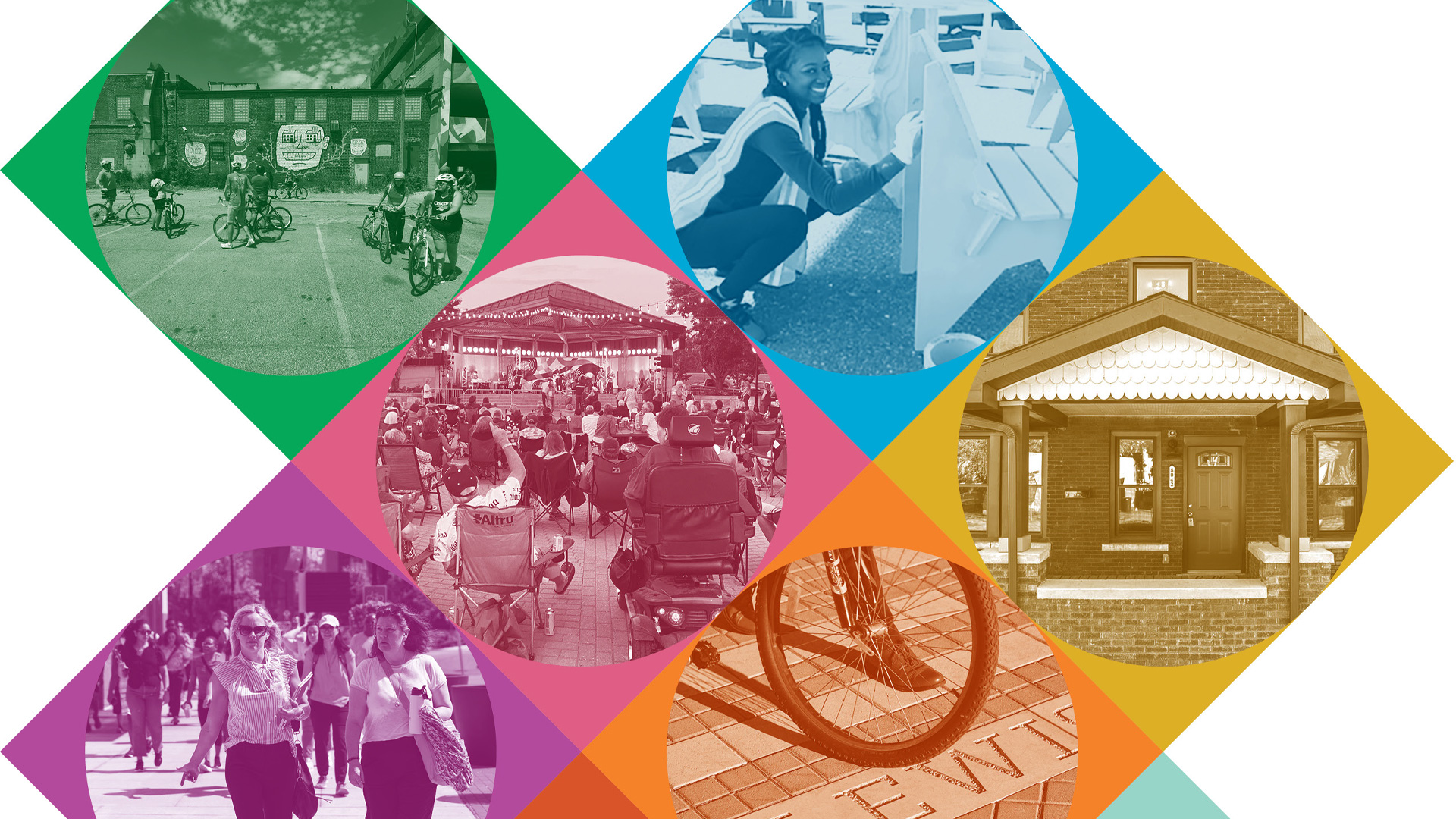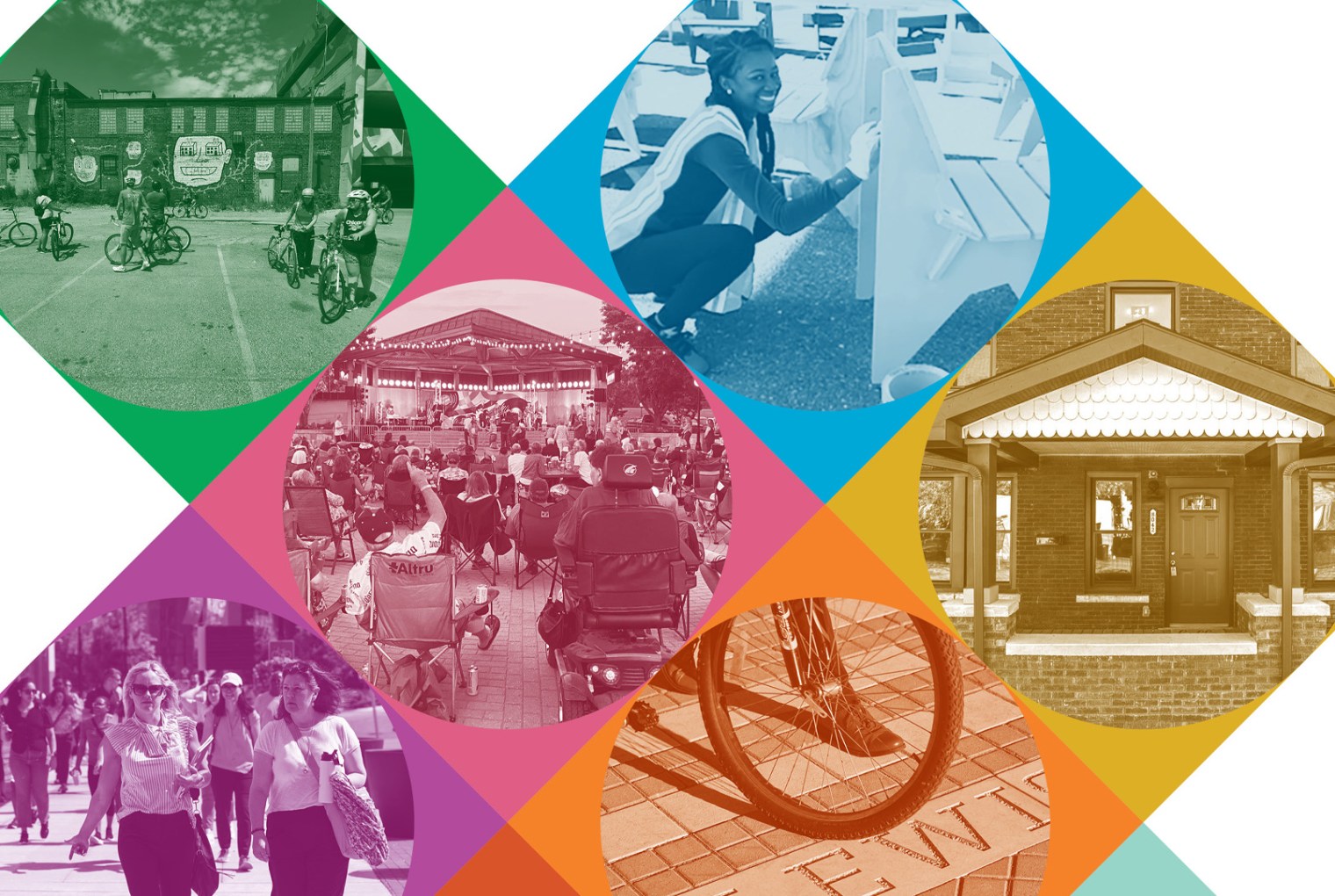To learn more about our approach, read this note by VP/Learning and Impact Ashley Zohn and VP/Communities and National Initiatives Kelly Jin.
To learn more about the key insights identified by HR&A Advisors, read this blog.
EXECUTIVE SUMMARY
Knight Foundation engaged HR&A Advisors, Inc. (HR&A) to evaluate the impact of its philanthropic grantmaking in supporting revitalization efforts in select downtowns and neighborhoods. This report is composed of three main sections: (1) an introduction to revitalization and markers of successful revitalization; (2) an overview of specific cities that have received revitalization-focused investments; and (3) a concluding summary of best practices and implications for future investment strategy. The city-specific overviews are particularly in-depth for five locations that have received greater levels of revitalization-focused philanthropic investments over time: Akron, OH; Charlotte, NC; Detroit, MI; Macon, GA; and Saint Paul, MN. Higher-level observations are noted for four additional cities where Knight makes investments through local community foundations: Gary, IN; Grand Forks, ND; Lexington, KY; and West Palm Beach, FL.
Implications for Future Investment
Each community’s path to revitalization is distinct, the result of unique characteristics and dynamics on the ground. In addition, each community is at a different point on its revitalization trajectory. That said, three overarching themes emerged as key factors in these cities’ revitalization trajectories: (1) local context: factors relating to the local environment, including physical and political context; (2) accelerators of impact: factors relating to where and to whom social investors direct funds in order to drive impact; and (3) concentration of investment: factors related to how and where investment activity is focused. These themes are explored in the third section of the report and are summarized below.
Local Context
- Think beyond the central business district: While downtowns may no longer serve as employment hubs due to permanent changes brought on by the COVID-19 pandemic, they continue to hold clear value as mixed-use districts that anchor a region. Traditional downtowns that centered on employment, like Akron and Saint Paul, faced greater impacts from the pandemic when compared with downtowns that offer a mix of uses (e.g., Macon), as well as neighborhoods that are oriented to residents as opposed to employees (e.g., Charlotte’s West End, Detroit’s North End). This contrast highlights the success of “Main Street” downtowns over corporate downtowns. Moreover, sustainable downtowns are marked by their ability to be inclusive, welcoming and vibrant to all residents.
- Build broad coalitions to ensure longevity: Broad and authentic coalitions that bring together a mix of dedicated stakeholders both inside and outside city hall help investments stay the course even during times of political administration turnover.
- Proactively mitigate displacement risk: Organizations committed to advancing revitalization must contend with the pressing risk of displacement that arises with new investment. Responses must be proactive and community-specific—the displacement risk in a city with rising rental prices and an influx of new residents is much higher than in a city where there is overall population loss.
Accelerators of Impact
- Cluster investments: Revitalization efforts are more likely to have a transformational impact when they are geographically concentrated and sustained over a longer period, so that successes can build upon one another and create broader momentum. Sustained investments in the creation of dedicated downtown organizations are particularly beneficial.
- Support multiple organizations working toward shared goals: In communities with an array of fiscally healthy and high-capacity organizations, investors should consider distributing funds across multiple organizations that fill different niches and reflect the community’s diversity but whose activities are ultimately in service of shared goals. In these cases, a first step in coalition building should be the collaborative development of a guiding strategy. In communities without a density of high-capacity organizations, it is more effective to invest in capacity building by concentrating investments with a few select organizations.
- Cultivate relationships with educational anchors: Fostering relationships and strengthening university connections can yield significant and sustained improvements in downtown vibrancy and growth.
Concentration of Investment
- Embrace flexibility and innovation: Flexible funding mechanisms such as seed funding, small grants, learning opportunities and pilot funding for new ideas are ways that social investors can support innovation and deliver wins for the community.
- Achieve long-term impacts by investing in programming, arts, the public realm and infrastructure: The strategy of focusing on public realm improvements to existing urban assets such as parks, open spaces and arts institutions has proven to be an effective path to building vibrancy. Financial support for the planning and construction of major public realm and infrastructure improvements has been transformational.
- Investing in multiple avenues to revitalization: Social investors should prioritize investments that align with a community’s priorities and respond directly to inclusivity and sustainability challenges. Support for economic innovation and inclusive entrepreneurial activity have been particularly successful.
City-Specific Findings
The communities included in this study encompass an array of different densities, demographic mixes and economic trajectories, much of which are driven by citywide or even regional trends. These communities were chosen not because they are a representative sample of cities across the U.S. but because they are communities where Knight has invested. Though each community faces its own challenges and opportunities, shared learnings are particularly evident when the case studies are grouped into three typologies: downtown cores (Akron, Macon, Saint Paul); historically Black neighborhoods that do not encompass their city’s traditional central business district (Charlotte’s West End, Detroit’s North End); and cities in which Knight’s investments are made through a local community foundation (Gary, Grand Forks, Lexington, West Palm Beach). To gauge the extent of revitalization, the study relied on quantitative demographic and real estate data, qualitative grantee interviews and, in five instances, in-person site visits and a survey. Findings are summarized below:
Downtowns
- Akron: Akron faces a steep path to revitalization. Both the city overall and downtown are losing population, a trend projected to continue, and the central business district is still recovering from the pandemic. While placemaking efforts are underway and show promising trends, downtown revitalization is still in its early stages and its future trajectory is uncertain.
- Macon: Over the past two decades, Macon has taken tremendous steps to reimagine and transform its urban core. A clear guiding vision and strong partnerships have helped increase vibrancy and deliver many markers of successful revitalization. Looking to the future, diverse, representative leadership and participation from residents of all backgrounds will be essential.
- Saint Paul: Downtown Saint Paul has begun to revitalize, with some limited signs of improvements to the public realm. But overall, downtown has been severely impacted by a slow return to office following the pandemic. Growth in downtown’s residential base is a positive trend in Saint Paul’s revitalization trajectory. However, a vision is needed for downtown to guide future growth, which will require support and a significant scale of investment from public, private and philanthropic sectors.
Neighborhoods
- Charlotte: The West End is undergoing clear signs of revitalization, with population growth and market activity indicating forward momentum. The community’s focus on increasing Black and Brown business ownership has advanced with the opening of several new commercial ventures, including Rita’s Ice Cream, Jet’s Pizza and Archives CLT coffee shop, each of which has benefited from philanthropic support. That said, the ongoing loss of the neighborhood’s Black population highlights the importance of mitigating against displacement to preserve the West End’s historic and cultural role as a Black neighborhood.
- Detroit: Philanthropic funding in the North End is in its nascent stages and, for many grants, it is too early to see impact. Demographic data shows that while Detroit is losing residents, the North End is contracting even more rapidly than the city overall. In particular, the North End is losing its Black population, and those who remain are increasingly low-income. Early efforts to revitalize the North End signal that there is much work to be done to transform the neighborhood. It will be important to monitor the outcomes of new developments in the area, and the subsequent impacts on demographics, most especially the economic conditions for Black residents and business owners.
Other Cities
- Gary: Downtown is facing serious population decline, mirroring trends in the broader city of Gary. Ongoing issues of blight and lack of development have stalled attempts at revitalization, and downtown Gary has seen little new development (the single new downtown development in the past ten years is a mixed-income project that received state and local incentives and abatements) and has not been able to attract new residents. Community stakeholders stressed that funders could play a valuable role in building the capacity of nonprofits working in Gary across a variety of focus areas, including public art, downtown beautification, job training and food access.
- Grand Forks: Despite signs of nascent revitalization in downtown Grand Forks, the area is still contending with a shrinking population, job losses, and a slow multifamily market. Over the past ten years, there has been little new development in this area. However, recent news reports and the number of development projects approved by the planning department indicate that the market is beginning to gain momentum and to overcome impacts of the devastating 1997 flooding and of the pandemic. Looking to the future, there should be a focus on strengthening ties between the University of North Dakota and downtown, including continued support for physical improvements to make the corridor more walkable.
- Lexington: Downtown Lexington has experienced transformative change via public realm improvements and major placemaking investments. Its successful revitalization is highlighted by a population that has grown rapidly over the past decade. The central business district is becoming increasingly expensive, and the scarcity of affordable housing developments is leading to growing displacement risks, spotlighting the importance for future investments to center inclusivity and ensure downtown remains a place for all.
- West Palm Beach: Downtown’s current growth trajectory is fueling revitalization. In response to population growth, the real estate market has been very active in the past decade. Leaders in West Palm Beach have made significant investments in the public realm to help attract residents, businesses and visitors. However, such rapid development has also led to rising prices and deepening affordability concerns, posing a significant risk of displacement for lower-income residents and people of color, who are already underrepresented in both business ownership and homeownership.

